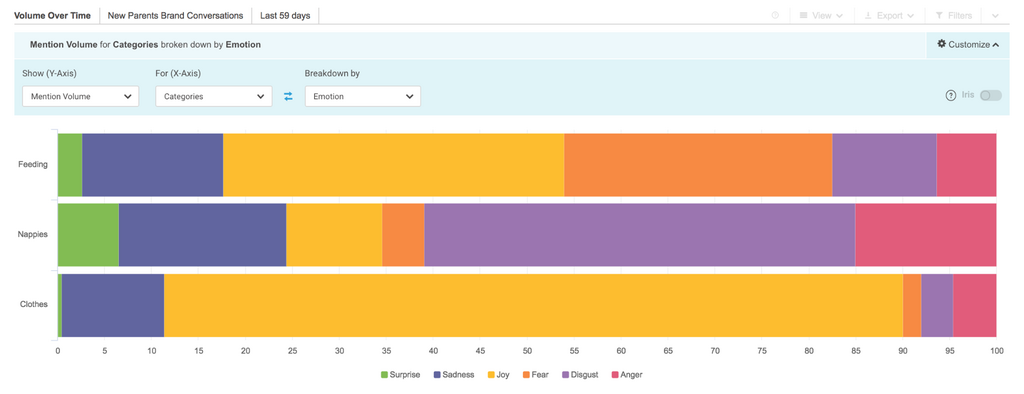Sentiment analysis is a critical component of social listening. It lets you take an instant ‘health check’ to understand if public opinion surrounding your brand is in the green or in the red.
It can be used to benchmark your favorability against the competition and it can help you detect reputation threats before they become a crisis.
Now, with emotion analysis in Brandwatch, you can dive even deeper into the public sentiment surrounding your brand, campaigns, or relevant topics to inform your reporting and strategies.
How does it work?
We use the list of six basic emotions as defined by the famous psychologist Paul Ekman to classify mentions:
- Anger
- Disgust
- Fear
- Joy
- Surprise
- Sadness
Emotion is assigned to mentions automatically by the Brandwatch system, using a custom statistical classifier which was created in-house by our team of data scientists.
You can then filter or chart by any of those emotions to view the emotive mentions in your data set however you like. You can even set up custom alerts to detect sudden increases in a particular emotion surrounding your brand.
Mentions can be reclassified with any emotion using Rules if you know that certain words or phrases indicate a specific emotion in the context of your brand or industry.
Brand reputation: Employing emotional intelligence
Emotion analysis can help you be more reactive to potential crises, providing you with a real-time monitor of how people who are talking about your brand are feeling.
For example, you could detect a surge in angry customers and identify the cause by setting up a custom alert looking for an increase in that emotion.
If you are already in the midst of a crisis, emotion analysis can still help you respond in a more efficient or appropriate way. By understanding how people really feel about an incident or story as it unfolds you can make a more informed decision about your response.
For example, you might be dealing with a negative news story published about your brand. Are people simply sharing the story without comment or are they expressing their rage or disgust? Or do they actually find the story amusing but don’t feel it reflects that badly on your brand per se?
Each type of emotional response from consumers could change how you want to actually deal with the situation.
Content: Hitting the right emotional tone
Not every product needs to be marketed with the same emotional tone. We’re unlikely to feel the same way about buying or using new toothpaste as we do about a new pair of shoes.
Seeing how your target audience talks about the products or services you offer, or when they’re in need of them, can help you be more authentic and address them in a tone that fits the situation.
For example, new parents might be talking joyfully about the first months of child rearing in the context of buying their baby’s first set of clothes, so an upbeat tone could work well in your own content if that’s what you’re promoting. But if they’re feeling sadder or even fearful about starting breastfeeding perhaps you need to consider a reassuring or more practical tone if your products are related to that aspect of parenting.
Brands such as Babies R Us and Yoplait, noticing these kinds of consumer conversations that happen in the early days of parenting, have started to shift from glossy, aspirational ads to more honest, relatable content that resembles the kind of worries parents are sharing and talking about online.
Emotional analysis can also help you understand your customers response to the content you’re producing. Are you ‘surprising’ your audience and making them laugh with your edgy ad campaign or did it make them feel queasy, or worse… angry?
Customer service: When emotions run high
In the world of customer service, timing is critical. A useful response, given quickly, can actually turn a potential problem situation into a positive moment.
Detecting conversations that are highly emotional can help you triage your social mentions to quickly assign staff to the people who’s anger or frustration is boiling over.
You can also dive into the angry mentions about your brand to get a better understanding of what specifically makes your customers furious so you can plan ahead to be better equipped to provide positive customer experiences in the future.
At the same time, customer engagement doesn’t always need to be emotionally charged in a negative way. Seeing when you’ve made peoples’ day or surprised them with a quick resolution can help you measure the impact of your services team on building positive customer experiences and brand loyalty.





